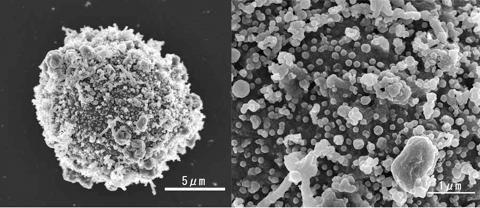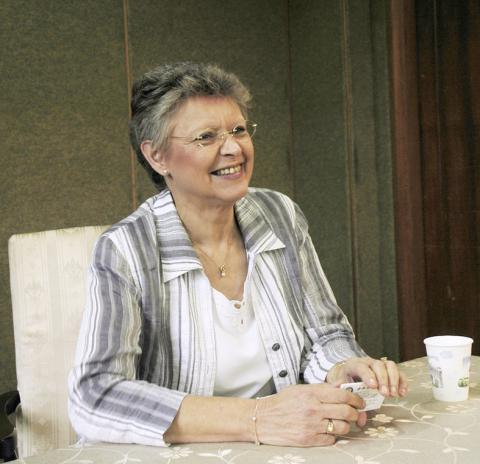Researchers should revisit “basic science” in the ongoing search for an HIV vaccine, says Francoise Barre-Sinoussi, who
shared the Nobel Prize in Medicine or Physiology in 2008 for codiscovering HIV and its role in causing AIDS.
The French virologist and public health activist was in Taipei last week to deliver a lecture at Academia Sinica, after which she spoke at a press meeting attended by the Taipei Times about the scientific and social challenges caused by HIV and AIDS.

Photo: Bloomberg
Since Barre-Sinoussi, along with her colleague and Nobel corecipient Luc Montagnier, first identified HIV in 1983, a working vaccine for the retrovirus has proven elusive.
One of the more promising vaccines in recent years was declared a failure in 2007.
For Barre-Sinoussi, one example of going back to “basic science” in HIV research would be to take a step back from clinical trials and examine vaccines that are successfully prevent other diseases.

Photo: David Chen, Taipei Times
This is an area worthy of exploration, said Barre-Sinoussi, as few scientists have “been interested in trying to find the real mechanism of induction of protecting the immune response.”
“It’s a very simple question: how [do] vaccines that are working work? And some [researchers in the US], for example, are interested in studying the yellow fever vaccine, a vaccine that works perfectly well. They’re trying to understand from the beginning how the vaccine works,” she said.
Asked whether she felt frustrated about the lack of an HIV vaccine, Barre-Sinoussi replied: “I was particularly frustrated when we did not have any treatment. But today ... we have highly active the anti-retroviral therapy [also known as HAART, the current multi-drug treatment method for HIV patients]. We don’t have a cure, but we have a treatment. And people on the treatment are living with HIV.”
“We don’t speak anymore about AIDS,” she said. “We are speaking about chronic HIV infection and HAART. I feel much better.”
A cure, if it’s defined as “ total eradication of the virus from the body,” for HIV may never be found, said Barre-Sinoussi.
However, she says there is hope for a “functional cure,” one that would control the immune defenses of someone infected with HIV, and prevent the virus being transmitted.
Barre-Sinoussi says she believes such a cure is possible because there are cases of HIV-positive people who show no symptoms and have very low levels of the virus in their blood.
“It exists in a few people we call controllers, natural controllers,” said Barre-Sinoussi. “They are not treated. They are infected for more than 10 years, some of them 15 years. They have never received any anti-retroviral treatment, they do not have any detectable viruses in their blood ... but they are [HIV] positive, and of course by very sensitive techniques we can detect the virus.”
If such a defense exists naturally, “we should be able to induce it,” she said.
Barre-Sinoussi, 63, is also known for her work outside of the lab. She has worked all over the world, particularly in developing nations, and helped establish HIV monitoring and treatment networks in the Central African Republic, Cameroon, Vietnam and Cambodia.
She is a vocal advocate of education and prevention programs that combine risk-reduction measures, such as anti-retroviral treatments, widespread HIV testing, circumcision — which according to Barre-Sinoussi reduces the risk of infection by 50 percent — and the use of condoms.
Barre-Sinoussi said that condoms are one of the “best vaccines” available, a position that has placed her at odds with religious leaders.
Last year, she wrote a public letter of protest to Pope Benedict XVI over controversial remarks he made on a visit to several African nations.
“[The Pope] said that condoms were not efficient, on his way to Cameroon, a country with around 12 percent [of the population suffering from] HIV infection. This is not acceptable. This is even criminal,” she said. “So all the work done [over] many years — only a few minutes
of such a ridiculous statement — is changing totally the situation in one country.”
Barre-Sinoussi, one of the relatively few women to have received a Nobel (40 women have won a Nobel as of last year, compared to 762 men), also spoke about women in science.
She describes the current situation where she works at the Pasteur Institute in Paris as a “positive evolution.”
“Twenty-five years ago ... there were only very few female researchers, as professors of the Pasteur Institute,” she said. “Today, I don’t have the exact number in my head, but I don’t think we are far from 50-50, now it’s maybe 40-60, something like that. Even the president of the Pasteur Institute today is a woman.”
She recalled once being told by a male researcher to change her career strategy because a “woman has never done anything in research.”
“I thought of the same thing when my father said, ‘Are you sure you want to study at the university?’ You’d better think of getting married and having children.’ [With the male researcher], I had the same thought in my head: ‘I’m going to show you what a woman is capable of doing.’”
Barre-Sinoussi says another urgent problem with HIV lies in providing “immediate access to treatment” in poorer countries, and the solution is partly political.
She said that the G20 countries in particular need to live up to their commitments as donors to the UN’s Global Fund to Fight AIDS, Tuberculosis and Malaria, and rich countries in general need to give even more money, with dire consequences looming if they do not.
“They have to realize if they don’t do it, it will be a catastrophe. At the global level,” she said. “If we cannot continue to treat the patients that are already on treatment, they will develop resistance to anti-retroviral treatment. And the strains of viruses that are resistant to anti-retroviral treatment will circulate, everywhere in the world. What are we going to do? So we will have a reemerging HIV epidemic. They will be responsible for that situation. They will be responsible for the deaths of people, everywhere in the world.”

June 2 to June 8 Taiwan’s woodcutters believe that if they see even one speck of red in their cooked rice, no matter how small, an accident is going to happen. Peng Chin-tian (彭錦田) swears that this has proven to be true at every stop during his decades-long career in the logging industry. Along with mining, timber harvesting was once considered the most dangerous profession in Taiwan. Not only were mishaps common during all stages of processing, it was difficult to transport the injured to get medical treatment. Many died during the arduous journey. Peng recounts some of his accidents in

“Why does Taiwan identity decline?”a group of researchers lead by University of Nevada political scientist Austin Wang (王宏恩) asked in a recent paper. After all, it is not difficult to explain the rise in Taiwanese identity after the early 1990s. But no model predicted its decline during the 2016-2018 period, they say. After testing various alternative explanations, Wang et al argue that the fall-off in Taiwanese identity during that period is related to voter hedging based on the performance of the Democratic Progressive Party (DPP). Since the DPP is perceived as the guardian of Taiwan identity, when it performs well,

The Taiwan People’s Party (TPP) on May 18 held a rally in Taichung to mark the anniversary of President William Lai’s (賴清德) inauguration on May 20. The title of the rally could be loosely translated to “May 18 recall fraudulent goods” (518退貨ㄌㄨㄚˋ!). Unlike in English, where the terms are the same, “recall” (退貨) in this context refers to product recalls due to damaged, defective or fraudulent merchandise, not the political recalls (罷免) currently dominating the headlines. I attended the rally to determine if the impression was correct that the TPP under party Chairman Huang Kuo-Chang (黃國昌) had little of a

At Computex 2025, Nvidia CEO Jensen Huang (黃仁勳) urged the government to subsidize AI. “All schools in Taiwan must integrate AI into their curricula,” he declared. A few months earlier, he said, “If I were a student today, I’d immediately start using tools like ChatGPT, Gemini Pro and Grok to learn, write and accelerate my thinking.” Huang sees the AI-bullet train leaving the station. And as one of its drivers, he’s worried about youth not getting on board — bad for their careers, and bad for his workforce. As a semiconductor supply-chain powerhouse and AI hub wannabe, Taiwan is seeing